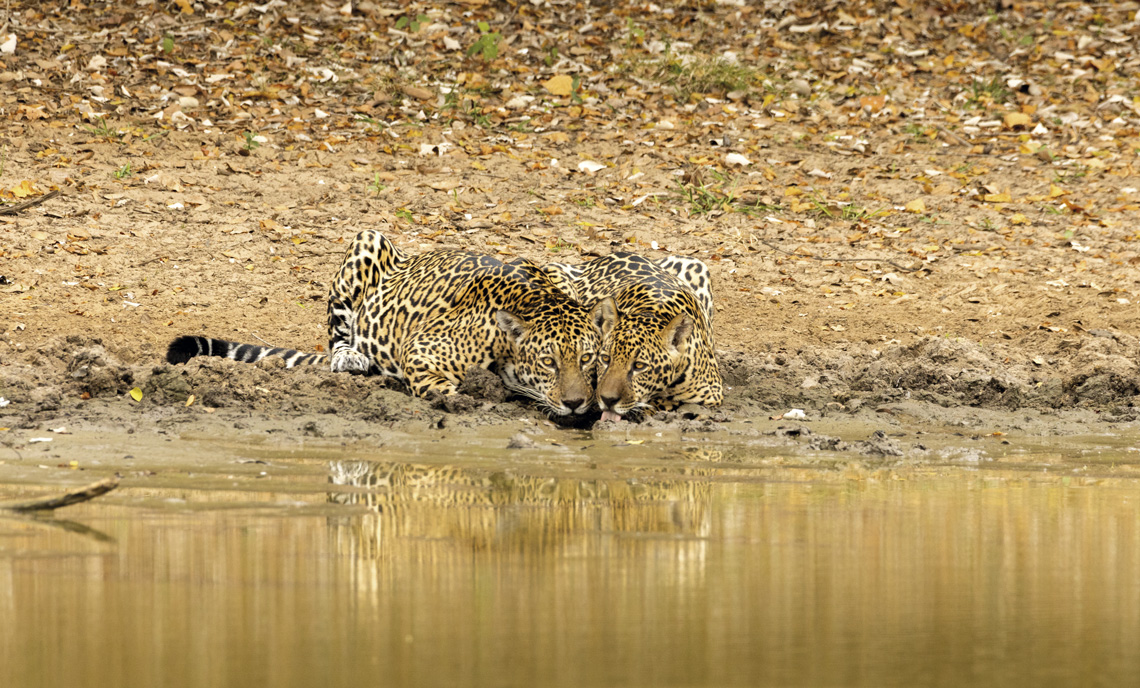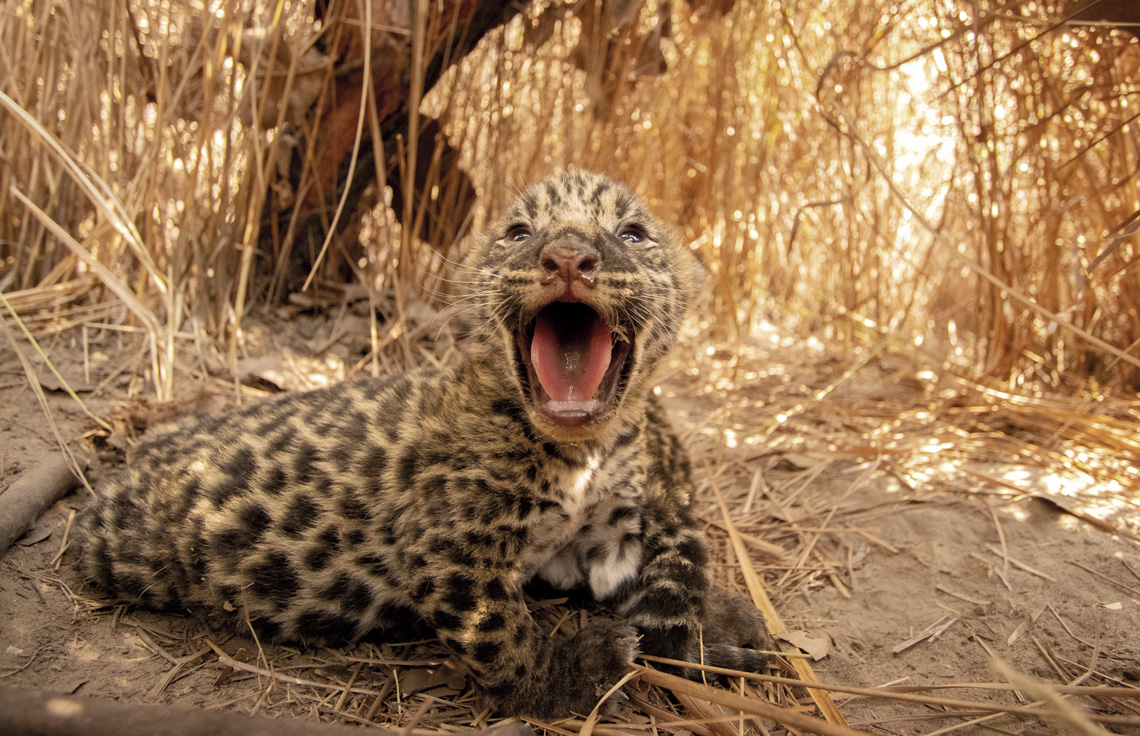At the end of 2021, biologist Edu Fragoso received a fairly common Christmas gift from his mother: a photo album. What was unusual, however, was that it did not contain memories of family moments or vacations, but images of the researcher at work in the Pantanal with the subjects of his research: jaguars. Every time he and his team approached a jaguar to collect data for their research, he sent a photo of the animal to his mother Bernadete via WhatsApp, including details such as its size, the name they had given it, and any interesting characteristics. The researcher’s mother included this information on the back of each photo.
Fragoso has been monitoring jaguars in the Pantanal since 2015. In a recently published article, he and his team of 11 researchers from the nongovernmental organizations Onçafari and Panthera described how they assessed the reproductive habits of 180 individuals that live freely in the Caiman ecological reserve in Mato Grosso do Sul, an area of 53,000 hectares that includes 56,000 square kilometers of legal preservation area.
A jaguar’s pregnancy lasts an average of three months. The reproductive age of females starts at 2.5 years and can last until they are 13—they live to around 15 and reproduce every two years. A female jaguar will have an average of eight cubs over the course of her life. The majority (65.7%) of the births recorded by the study involved just one cub, a quarter were twins and the remainder were triplets, according to an article published in the Journal of Mammalogy in January. Cubs become independent of their mothers at about 1.5 years old.
Fragoso and his team were delighted with the results. “These are important numbers. We observed a good level of population growth in the region; the environment is healthy and they can continue to survive for many years there,” says the scientific coordinator of Onçafari. “The females have been very successful at raising their young to independence.”
 Edu Fragoso / Onçafari
Edu Fragoso / Onçafari
The survival of jaguars in the Pantanal is based largely on the amount of prey to which they have access. “These felines lead a good, peaceful life here,” says Fragoso. The data behind the discoveries was collected for almost a decade with the help of cameras fitted with motion sensors, known as camera traps, which begin recording whenever they detect movement. The scientists also used GPS collars to monitor exactly where the jaguars were, to track their movements, and to identify pregnant females, whose movement decreases considerably during pregnancy.
To fit these collars, another type of trap was used: a snare that consists of a loop connected to a transmitter, set up in the middle of a trail and then camouflaged. When the jaguar steps into the trap, the loop tightens around its paw and the team receives a signal that it has been captured. They quickly go to the location and anesthetize the animal with a dart gun.
After the tranquilizer has been applied by a veterinarian, they have between 40 minutes and an hour to take measurements, such as weight and size, collect material for laboratory analysis, such as hair, saliva, and blood, and fit a GPS collar, which has a kind of shelf life, falling off by itself around 1.5 years later. The researchers stress that the collar is only placed on adult animals that will not grow any bigger and the anesthetic is not harmful to pregnant females.
“In the moment, we are focused on doing what we came to do, but being there in such close contact with these animals is indescribable,” says Fragoso. For the scientists, every jaguar is unique and is therefore given their own name: Esperança, Flor, Troncha, Ipê, Aroeira, Fera (and her baby, Ferinha). Fragoso’s favorite is Natureza. “She was the first one I saw in the wild when I arrived in the Pantanal,” he recalls. She has had 10 cubs since the biologist began monitoring her.

Edu Fragoso / OnçafariLong-term monitoring provides detailed data on the demography of jaguars in the PantanalEdu Fragoso / Onçafari
The researchers need to be particularly careful—and quick—when visiting the jaguars’ dens, which they can only do at all thanks to the GPS collars. Females generally remain as close to their newborn cubs as possible, but when a camera trap identifies one far from her litter, the team splits up. Half follow the mother and the other half go to the den to count the number of cubs. This is an important task because it tells the team how many cubs were actually born, rather than just how many survive and emerge from the den when they are more independent. “The teams communicate by radio and have to move very quickly,” says Fragoso, who emphasizes that the method is only used when the den is easily accessible, so that no changes need to be made that could expose the cubs to risks. “Without doing this, we could only see the cubs on the cameras once they reached 2 or 3 months old, but we couldn’t know how many had actually been born.” One of the next missions will be to measure the infant mortality rate of jaguars.
In addition to experience, being part of a team like Fragoso’s requires a high level of respect for safety protocols. The only way to get close to an awake jaguar is in a car. The jaguars in the region where Onçafari operates are already used to the sound of vehicles, so the noise does not affect their natural behavior. In addition to researchers, Caiman is also a popular destination for tourists. To date, the biologist has never witnessed any serious accidents, despite dealing with the largest jaguars in the world. “Jaguars don’t see humans as prey,” says biologist Alan Eduardo de Barros, a PhD student at the University of São Paulo (USP) who is studying the consequences of wildfires on the jaguar population in the Pantanal.
Adult males from the region can weigh over 140 kilograms (kg) and females over 80 kg. Jaguars from the Caatinga (semiarid scrublands) are usually lighter, with adult males weighing less than 50 kg. Barros, who has no relationship with Onçafari, believes Fragoso’s team was smart to carry out their study in the biome. “It is somewhat easier to observe large animals and birds in the Pantanal,” he points out.
It is a well-conserved biome with a high density of jaguars, says Ronaldo Morato, a veterinarian and head of Brazil’s National Center for Carnivorous Mammal Research and Conservation (CENAP) at the Chico Mendes Institute for Biodiversity Conservation (ICMBIO). “Some of the animal behavior there is more relaxed and there is less competition because there is more food available,” he explains. “Having this as a reference will allow us to make predictions about regions where it is harder to collect information,” he says.
 Edu Fragoso / Onçafari
Edu Fragoso / Onçafari
Another advantage was that the team observed the jaguars in a wildlife reserve that has also invested in tourism, including safari tours, meaning the animals are used to the presence of humans. It is essential to ally the interests of tourism to scientific research and preservation of the species, says Barros. “The potential is positive if it is done correctly,” he notes.
Technological advances also contributed to the close observation of the animals. In the 1970s, researchers used collars that emitted very high frequency (VHF) radio signals, not GPS. To capture these signals, Peter Crawshaw (1952–2021), a Brazilian pioneer in jaguar studies, had to fly over the Pantanal in an ultralight aircraft. “In the past, a really good study would identify around 60 location points over two or three years,” recalls Morato, who was one of the first to monitor jaguars with GPS. “Now we can capture 60 locations in three days, so the volume of data we can collect has increased immensely, as well as its accuracy.”
Modern computer technologies also allow researchers to analyze the large volume of data collected. “There are now ways of scrutinizing this information in much more detail,” points out Morato. “We can make identify complex associations that help us better understand the natural history of the species.”
Reproducing Fragoso’s study in other Brazilian biomes could be a challenge, especially in areas where jaguars are endangered, such as the Atlantic Forest and the Cerrado (wooded savanna), or outside the country. The hope is that the data collected in the Pantanal will help scientists assess population viability and plan for reintroduction of the species. Morato sees jaguars as a symbol that can be used to engage society in preserving the environment and biodiversity.
Scientific article
FRAGOSO, C. E. et al. Unveiling demographic and mating strategies of Panthera onca in the Pantanal, Brazil. Journal of Mammalogy. Online. Jan. 12, 2023.
